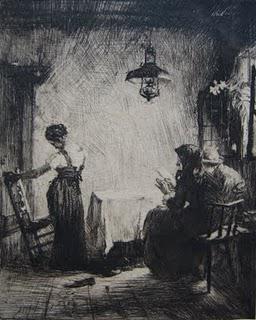 Ferdinand Schmutzer, Tagesneuigkeiten (The Day's News)Etching, 1908
Ferdinand Schmutzer, Tagesneuigkeiten (The Day's News)Etching, 1908Even when he depicts a crowd scene, as in his etching of poor citizens of Vienna crowding in a soup line outside a monastery or convent, there is no sense of jostling or hubbub; instead one senses the silent resignation of people too tired to make much noise. This etching, the smaller of two versions of the same scene, is my favourite among the five etchings I possess by Ferdinand Schmutzer. It shows him able to tackle a really complex composition with great finesse, and it also beautifully demonstrates Schmutzer's mastery of light effects. I can't put it better than Clive, who writes in his Art and the Aesthete post on Schmutzer, "He has unusual skill in balancing the plain darks and lights with delicately fretted greys."
 Ferdinand Schmutzer, Die "kleine" Klöstersuppe (The "little' Free Soup)Etching, 1907
Ferdinand Schmutzer, Die "kleine" Klöstersuppe (The "little' Free Soup)Etching, 1907Schmutzer came from an artistic family. He was the son of the animal sculptor Ferdinand Schmutzer, and grandson of the sculptor Vincent Schmutzer. His great-grandfather Jacob Mathäus Schmutzer founded the Imperial Academy of Engraving, which mutated into the current Vienna Academy of Fine Arts, where Ferdinand Schmutzer studied sculpture under Kuhne and etching under William Unger (winning the Prix National in 1894).
 Ferdinand Schmutzer, Entdecktes Geheimniss (The Secret Discovered)Etching, 1897
Ferdinand Schmutzer, Entdecktes Geheimniss (The Secret Discovered)Etching, 1897Ferdinand Schmutzer was himself appointed as a Professor at the Vienna Academy in 1908. He was a member of the Vienna Secession from 1901, and President 1914-1917. He was born, lived, and died in Vienna. He was an important figure in the artistic and cultural life of the city before and after the Great War, and was associated with Sigmund Freud, Albert Einstein, Richard Strauss, and Arthur Schnitzler.
 Ferdinand Schmutzer, Antwerpen (Antwerp)Etching, 1915
Ferdinand Schmutzer, Antwerpen (Antwerp)Etching, 1915Besides genre scenes such as my first three etchings, Ferdinand Schmutzer also produced elegant landscapes and cityscapes, in a style that shows the influence of German Impressionists such as Leopold von Kalckreuth and Paul Baum.
 Ferdinand Schmutzer, Blick auf die Kirche von Dürnstein (View of Dürnstein church)Etching, 1921
Ferdinand Schmutzer, Blick auf die Kirche von Dürnstein (View of Dürnstein church)Etching, 1921Ferdinand Schmutzer produced around 300 etchings, which have been catalogued by Arpad Weixlgärtner in Das radierte Werk von Ferdinand Schmutzer, 1922. He also left more than 3000 glass plate photographs, an important part of his artistic legacy that has only recently been uncovered. Like his etchings, Schmutzer's photographs are highly sensitive to the play of light and shade

